Audiences
Once a customer triggers a Journey, the Journey's Audiences determine who qualifies to move forward.
Audiences are used to segment customers into different Journey branches based on Filters that describe the customers you're trying to target.
Adding Audiences
To get started, click on Add New Audience once your new Journey has been created.
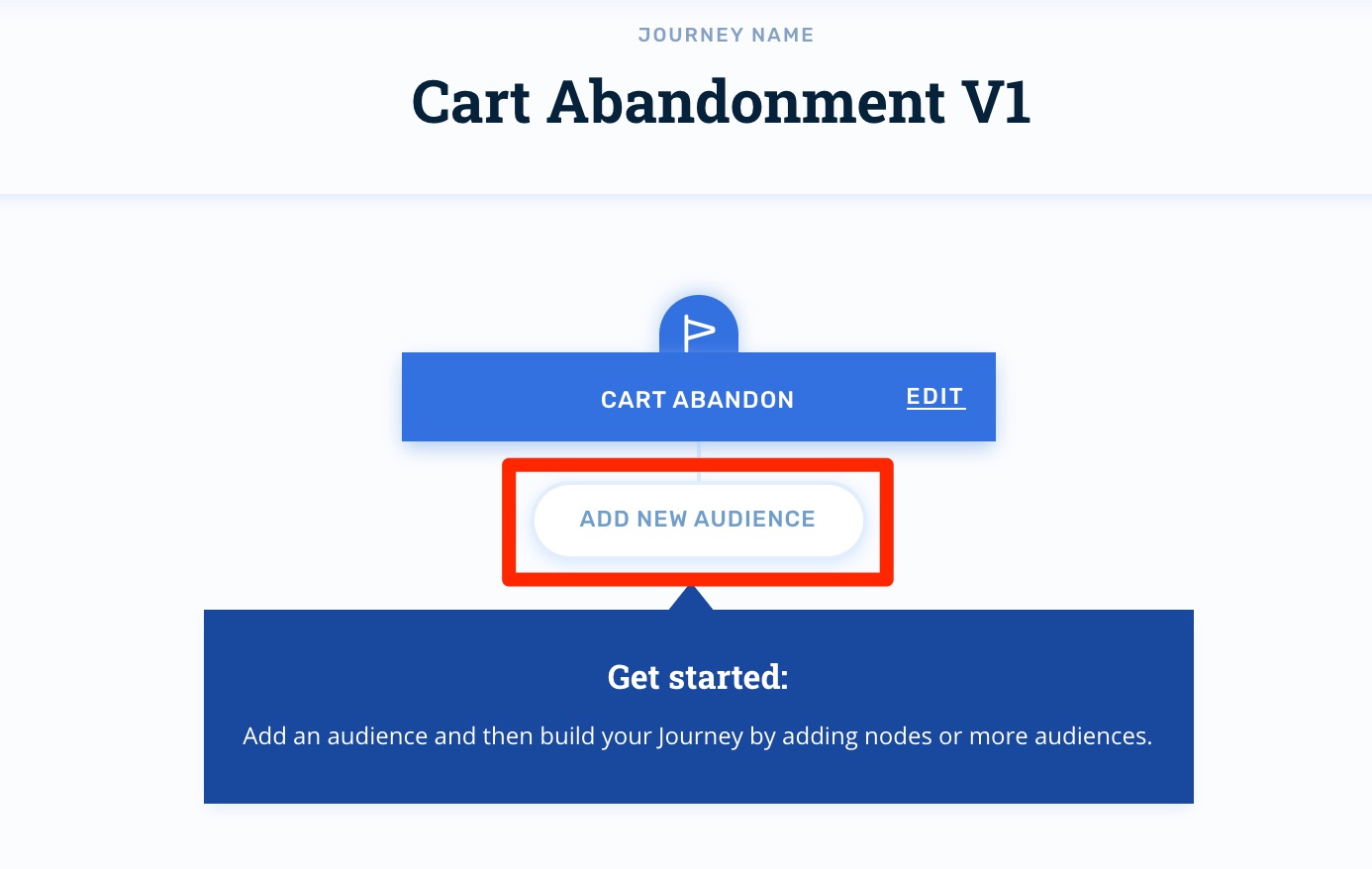
You can add as many audiences as you'd like and there is no limit. To add additional audiences, click Add New Audience and set your filtering criteria.
Prioritizing Audiences
Once a customer triggers a journey, Rejoiner will attempt to match them to an audience flowing from left to right. This means that the more specific your audience, the further left it should be prioritized in the Journey builder.
In this example, we would attempt to match the > $500 audience first, the > $100 audience next, and if the customer matched neither they would flow into the Catch-all. This enables you to prioritize audiences who have more specific filtering requirements, thus needing a more specific Journey experience.
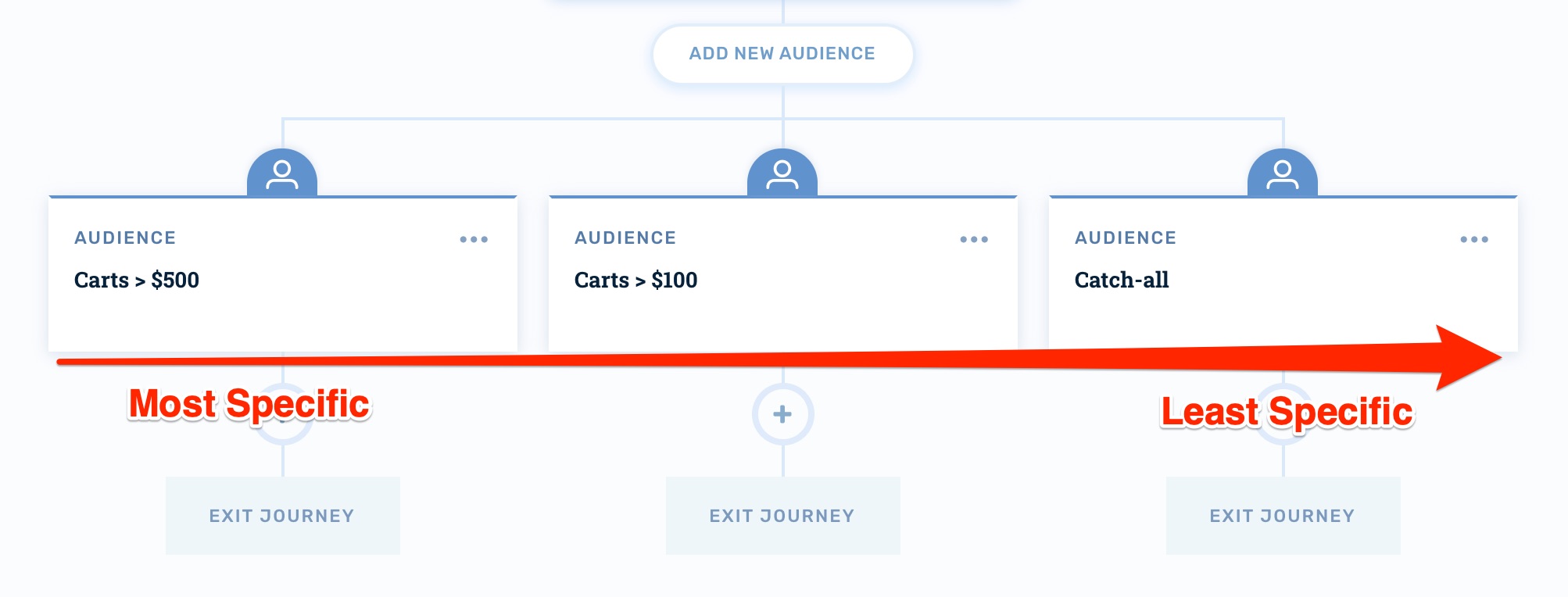
You can rearrange the positioning of audiences by clicking the Audience Options icon in the journey builder:
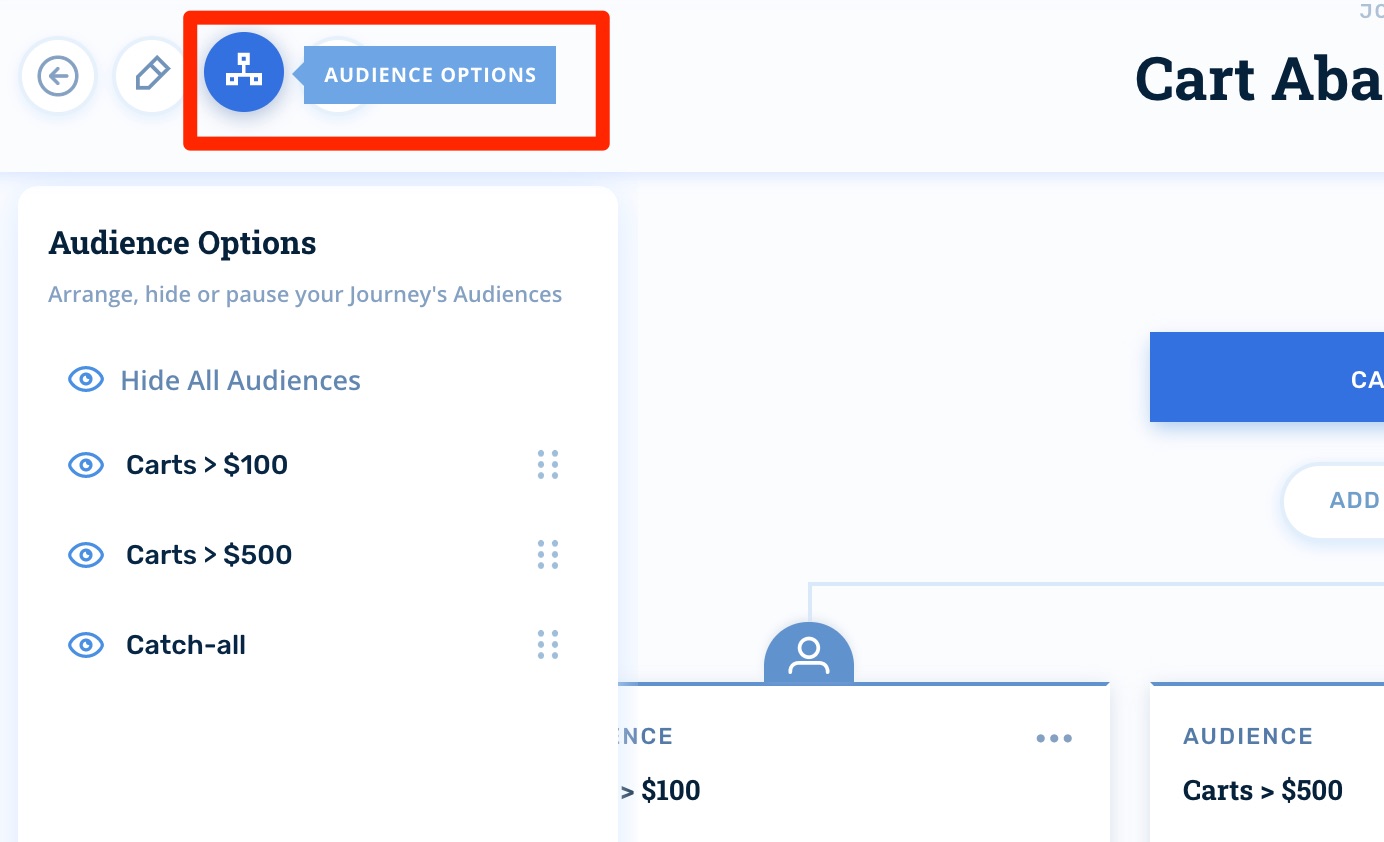
Then, drag each audience to reposition:
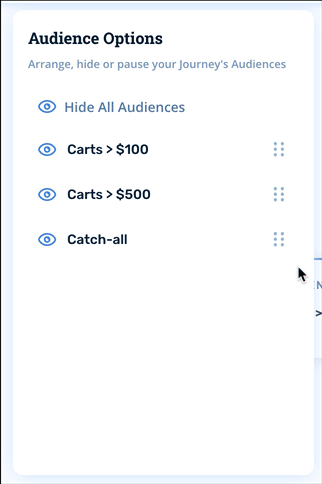
Audience Filters
Audiences are defined by filters and can describe customer demographics, purchase history, email channel engagement, or some combination of any of the filters listed in the table below.
Audience filters can be combined with AND or OR operators and there is no limit to how many filters can be used:
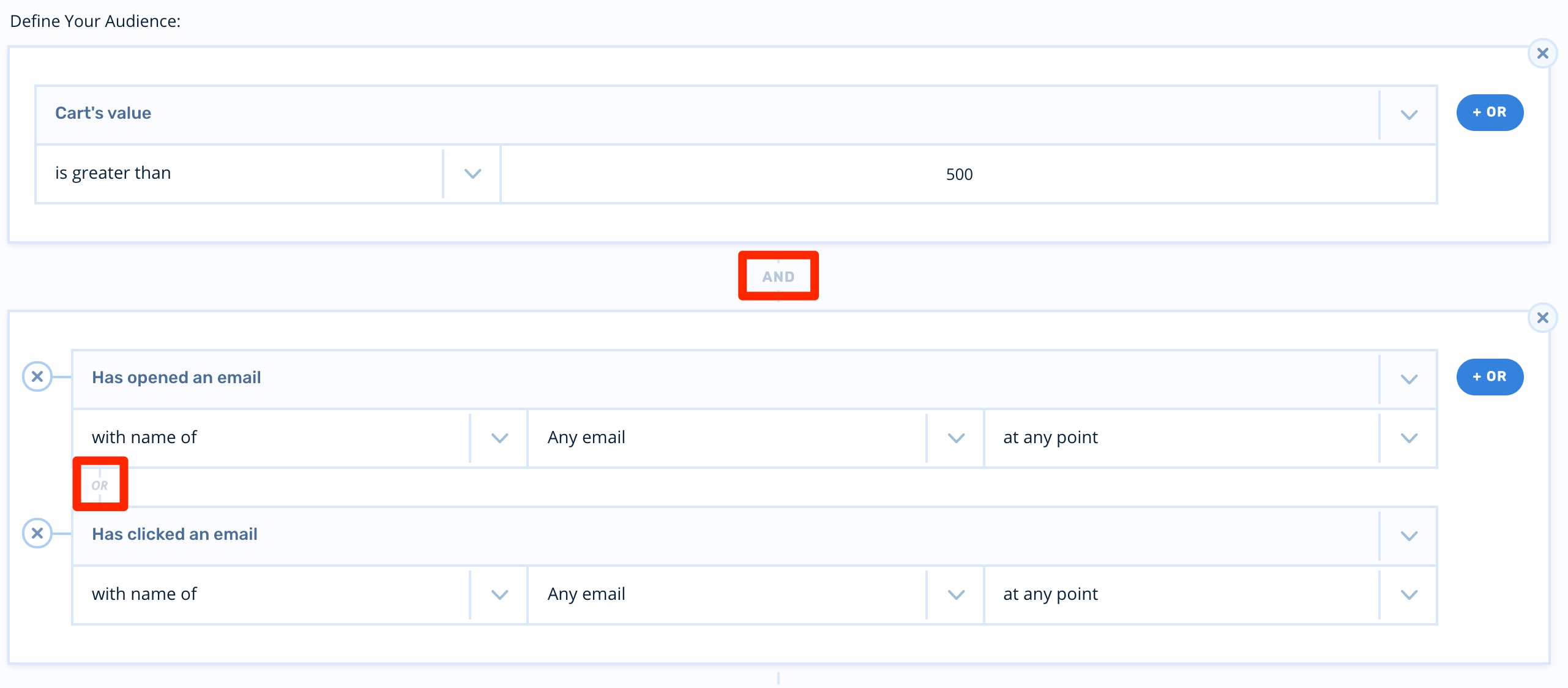
Filter | Definition |
|---|---|
Catch-all | All customers will qualify |
Customer email address | Customers will qualify based on their email address. |
Customer age | Customers will qualify based on their age, if available. |
Customer gender | Customers will qualify based on their gender, if available. |
Customer language | Customers will qualify based on their language. Language is determined by browser data. |
Customer opt-in status | Customers will qualify based on their opt-in status. |
Customer unsubscribe status | Customers will qualify based on their unsubscription status. |
Customer's tags | Customers will qualify based on the presence or absence of tags. |
Customer abandon count | Customers will qualify based on how many times they've abandoned. |
Customer conversion count | Customers will qualify based on how many times they've purchased. |
Customer total revenue | Customers will qualify based on how much revenue they've generated in their lifetime. |
Customer conversion count | Customers will qualify based on how many times they've purchased. |
Customer average order value | Customers will qualify based on their average order value. |
Customer created (since) | Customers will qualify based on the age of their profile. |
Customer has purchased product with ID | Customers will qualify if they have purchased the specific product ID. |
Customer has not purchased product with ID | Customers will qualify if they have not purchased the specific product ID. |
Customer has purchased product with name | Customers will qualify if they have purchased a product with a name that matches. |
Customer has not purchased product with name | Customers will qualify if they have not purchased a product with a name that matches. |
Customer has purchased an item whose product categories | Customers will qualify if they have purchased a product with categories that match. |
Cart item name | Customers will qualify if they have a cart item with a name that matches. |
Cart item price | Customers will qualify if they have a cart item with a price that matches. |
Cart item quantity | Customers will qualify if they have a cart item with a quantity that matches. |
Cart item product ID | Customers will qualify if they have a cart item with a product ID that matches. |
Cart item categories | Customers will qualify if they have a cart item with categories that match. |
Cart item description | Customers will qualify if they have a cart item with a description that matches. |
Cart item expiration date | Customers will qualify if they have a cart item with an expiration date that matches. |
Cart item was updated | Customers will qualify if they have a cart item that was updated within a timeframe that matches. |
Cart's value | Customers will qualify if they have a cart value that matches. |
Cart's item count | Customers will qualify if they have a cart with a number of items that match. |
Applied promo code | Customers will qualify if they applied a promo code to their cart that matches. |
Order number | Customers will qualify if they have an order number that matches. |
Cart data was updated | Customers will qualify if they have a cart that was updated within a timeframe that matches. |
Viewed item with product ID | Customers will qualify if they viewed a product detail page for a product ID that matches. |
Did not view item with product ID | Customers will qualify if they did not view a product detail page for a product ID that matches. |
Viewed item whose categories | Customers will qualify if they viewed a product detail page with categories that match. |
Product was viewed | Customers will qualify if they viewed a product within a timeframe that matches. |
Viewed page with URL | Customers will qualify if they viewed a URL that matches. |
Did not view page with URL | Customers will qualify if they did not view a page that matches. |
Viewed page with query string | Customers will qualify if they viewed a page that included a query string that matches. |
Has received an email | Customers will qualify if they have received an email that matches. |
Has not received an email | Customers will qualify if they have not received an email that matches. |
Has opened an email | Customers will qualify if they have opened an email that matches. |
Has not opened an email | Customers will qualify if they have not opened an email that matches. |
Has clicked an email | Customers will qualify if they have clicked an email that matches. |
Has not clicked an email | Customers will qualify if they have not clicked an email that matches. |
Has clicked link ID | Customers will qualify if they clicked a link ID that matches. |
Has not clicked link ID | Customers will qualify if they have not clicked a link that matches. |
Has clicked URL | Customers will qualify if they have clicked a URL that matches. |
Has not clicked URL | Customers will qualify if they have not clicked a URL that matches. |
Customer metadata | Customers will qualify if their profile contains metadata that matches. |
Session metadata | Customers will qualify if their session contains metadata that matches. |
Cart metadata | Customers will qualify if their cart contains metadata that matches. |
Cart item metadata | Customers will qualify if they have cart items containing metadata that matches. |
Subscribed to List | Customers will qualify if they are subscribed to a list or lists that match. |
Not subscribed to List | Customers will qualify if they are not subscribed to a list that matches. |
Custom field in list | Customers will qualify if they have a matching value in a list custom field. |
Customer is in a journey | Customers will qualify if they are currently in a journey that matches. |
Customer is not in a journey | Customers will qualify if they are not currently in a journey that matches. |
Customer has started a journey | Customers will qualify if they have started a journey that matches. |
Customer has not started a journey | Customers will qualify if they have not started a journey that matches. |
Customer has completed a journey | Customers will qualify if they have completed a journey that matches. |
Customer has not completed a journey | Customers will qualify if they have not completed a journey that matches. |
Customer is part of segment | Customers will qualify if they are part of a segment that matches. |
Customer is not currently part of segment | Customers will qualify if they are not part of a segment that matches. |
Customer was part of segment | Customers will qualify if there ever part of a segment that matches. |
Customer was not part of segment | Customers will qualify if they were never part of a segment that matches. |
Customer was in test | Customers will qualify if they were part of a test that matches. |
Customer was not in test | Customers will qualify if they were never part of a test that matches. |
Web browser country | Customers will qualify if their most recent session has a web browser country that matches. |
Web browser region code | Customers will qualify if their most recent session has a web browser region code that matches. |
Web browser postal code | Customers will qualify if their most recent session has a web browser postal code that matches. |
Web browser type | Customers will qualify if their most recent session has a web browser type that matches. |
Web browser device | Customers will qualify if their most recent session has a web browser device that matches. |
First abandon date was | Customers will qualify if their first abandon date occurred within a timeframe that matches. |
Last abandon date was | Customers will qualify if their last abandon date occurred within a timeframe that matches. |
First conversion date was | Customers will qualify if their first conversion date occurred within a timeframe that matches. |
Last conversion date was | Customers will qualify if their last conversion data occurred within a timeframe that matches. |
Pausing Audiences
There may be cases where you'll need to pause specific audiences while your journey is active. First, click Audience Options in the Journey builder.
Then, click the Pause icon next to the audience:
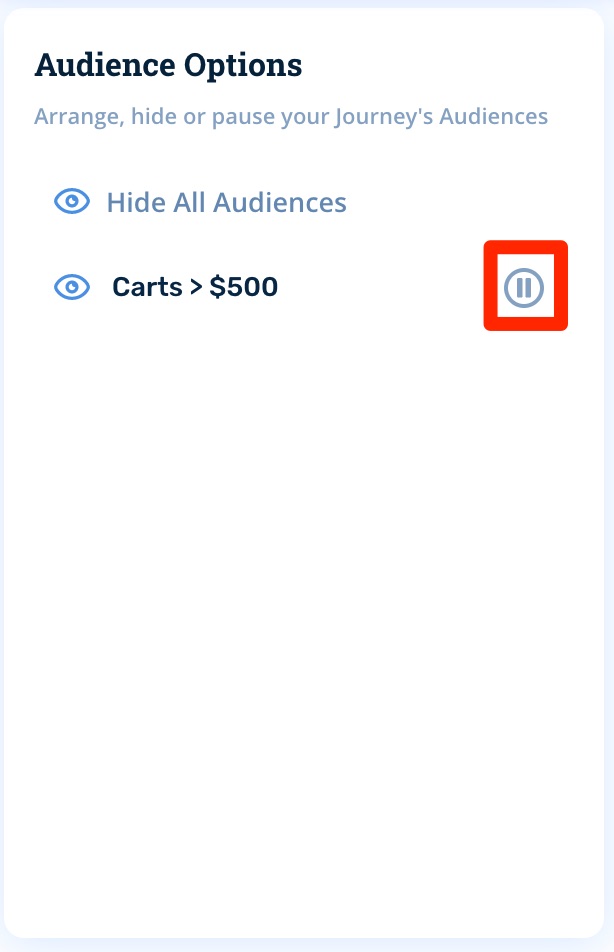
QA Audiences
It's common practice to run quality assurance testing on Journeys using audiences that are limited to specific email addresses or email domains. This prevents real customers from entering the journey while enabling you and your team to thoroughly test the experience.
- First, you'll need create an audience that leverages the Customer email address filter and limits qualifying email addresses to only those that you control:

-
Next, you'll prioritize this QA audience in the far left position.
-
Finally, you'll activate the journey and immediately pause the Non-QA audience. Now your journey is active, but only the QA audience will allow customers to enter.
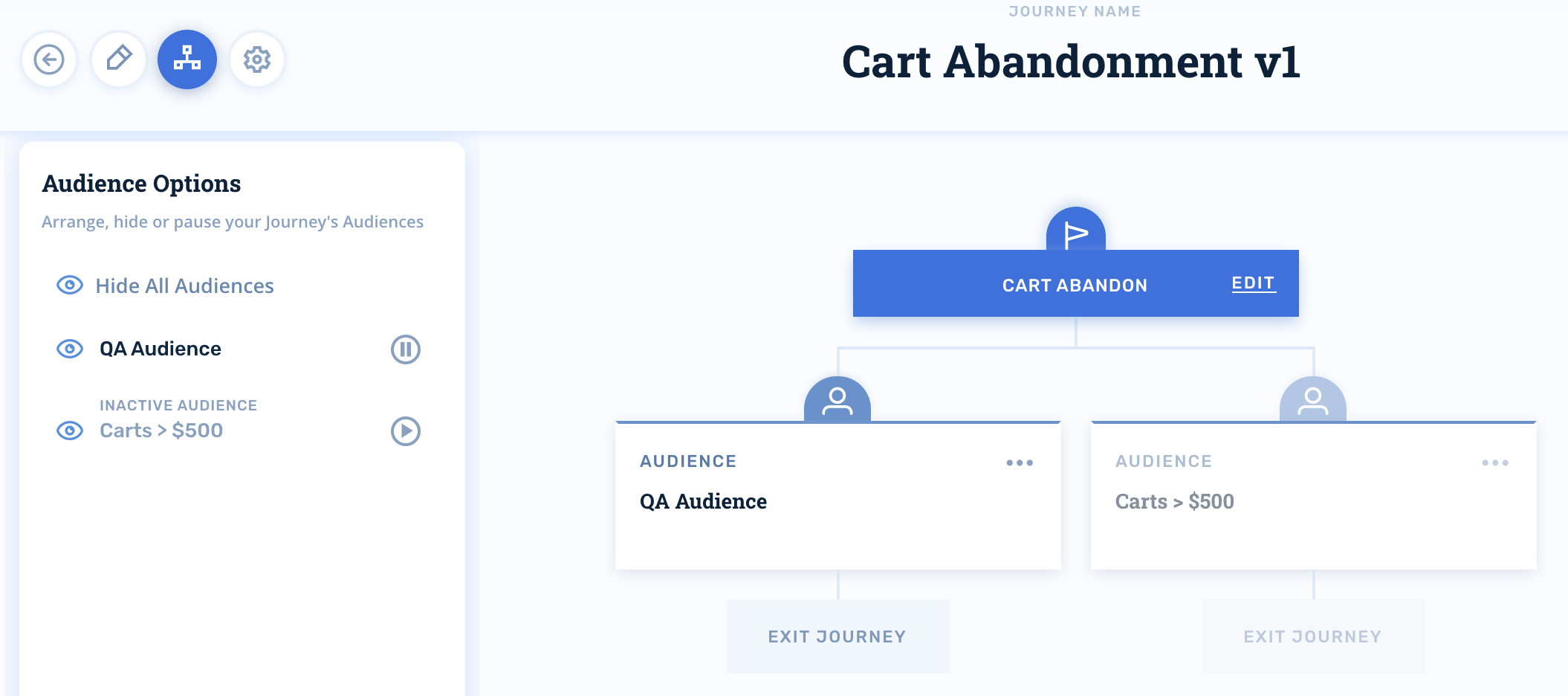
Updated 2 months ago
